DemandFarm’s Spring Release 2024 – Omphalos
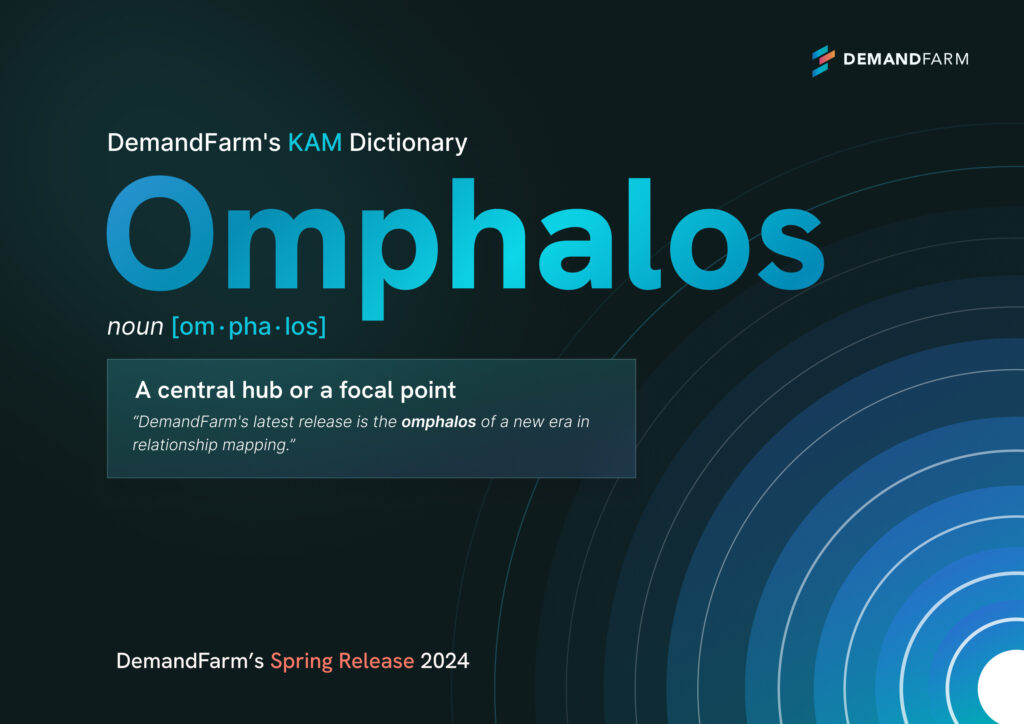
The Need for Relationship Mapping Goals in Enterprise Sales If you’re part of a B2B sales team, chances are that ABS as a strategy is on your radar. Account Based Selling (ABS) burst into the spotlight in the mid 2010s and has been steadily gaining traction as the go-to approach among B2B sales organizations. Who wouldn’t want to unlock the full potential of their key accounts? Identify your target accounts, put together a team of sales plus marketing, work out a hyper-personalized messaging and content strategy for those accounts, and measure your efforts. Sounds simple enough! The best account managers, however, have a secret sauce that differentiates them from the others. At the core of their ABS is an often-overlooked perspective–selling to the humans behind the steely structures that make up their accounts lists. While sales processes have moved forward by leaps and bounds, thanks to these sales champs, the technology that supports these power moves unfortunately has not. An account manager needs to keep a tab on several parameters while reaching out to different personas today to simply break through the everyday clutter. This is possible at scale provided the account manager has neatly laid out relationship goals for all the stakeholders in the account, especially the buying committee. As a company that works closely with key account management teams from across the globe, we have a vantage view to unfolding trends. What can be a blink and miss moment is slow motion for us. That there is a huge gap in how key account management teams are doing relationship mapping today would be an understatement. Only a handful of companies and sales leaders are laying down relationship targets, and an even smaller slice plots a course to hit them. The consequence? Relationship mapping is still ad-hoc. Account Managers are struggling to identify the right people, initiate meaningful conversations, keep track of who they’ve spoken to and stitch back their efforts to the larger business goals. While their work happens on CRMs partially, they tend to use ad hoc tools (or no tools sometimes!) to build org charts. Relationship Mapping and ABS Maturity Organizations at various stages of ABS maturity focus differently on relationship mapping. The more mature shops are eager to streamline their relationship mapping with technology. They understand that without technology they can’t systematize a process-driven approach to relationship mapping at scale. For them, nailing relationships is non-negotiable. “ They have realized that key account management in its simplest form is all about pure human-to-human connections in a B2B world. However, organizations that are just climbing up the ABS maturity ladder recognise the need for methodical relationship mapping but often default to manual approaches to tackle the challenge. While the manual fix might hold up in the short term, it often breaks when the business scales and more stakeholders become part of the engagement mix. Our latest release is aimed at helping both seasoned and emerging ABS-driven enterprises realize the benefits of tech-powered relationship mapping. We’re certain it’s time for a shift. KAM should no longer be seen solely through the ABS lens; it’s crucial to also see it through the people lens. As leaders, we’re committed to paving the path, highlighting that tech-enabled ABS isn’t just beneficial—it’s essential. The Unveil: Relationship Mapping that puts People at the Center. DemandFarm’s new and enhanced features released as part of Omphalos are designed to ensure your Account Managers (AM) are spending 100% of their time talking to the right people, building relationships that move deals forward and effortlessly track how effectively they are engaging the C-suite and other key stakeholders. Let’s dive in. Org Chart 2.0: More Intelligent. More Effortless. More Intuitive. Here’s an interesting discovery we made when we looked into our strategic account engagements: on an average, it takes at least 8 to 15 meetings and connecting with approximately 10 different stakeholders across more than four roles to lock in these strategic partnerships. While the specifics might differ based on your organization’s size, industry and multiple other factors, here’s a constant: strategic deals demand a higher-than-average number of touchpoints and stakeholder involvement. Pinpointing powerful contacts among thousands, distinguishing supporters from detractors, understanding their relationship dynamics all can be daunting if the vehicle you’re using to visualize and take action isn’t snappy. And this is exactly why we have made some massive upgrades to our Org Chart, especially from the lens of cutting down the time it takes for account managers to build context-rich ones. Here are the highlights: A Fresh Look That’s Designed To Help You Find Information Faster DemandFarm’s Org Chart looks all-new, but works exactly the way it used to. Only faster, easier to navigate, and every piece of context—from a stakeholder’s buying power, to their current status to associated opportunities—everything is now more intuitively visible. A single click on the contact card reveals every ounce of context there is to the contact. Brand-new filters, zippy pinch and zoom, the upgrades are aplenty. Creating and maintaining org charts is now faster and more delightful thanks to the latest UI update and some sleek under-the-hood technical improvements. Make it Dead Easy for your AMs to Prioritize who to include in their Org Charts, with Suggested Contacts Picture this: you’re an account manager who’s got 30 to 50 new contacts that are yet to be added to the org chart. Role changes, departures, new meetings and more, all these variables only end up making this task herculean. And now you’ve to figure out who among this sea of contacts to prioritize adding to the org chart. Most account managers are likely to find themselves stuck in analysis paralysis. They end up losing time choosing who to include instead of talking more with customers and partners. That’s the pickle we’ve set out to fix with Suggested Contacts. Suggested contacts is powered by an rule-based engine that takes into account a contact’s static, think role, title, etc. and evolving attributes—like their latest engagements
Case Study: Healthcare Industry Company Boosts Strategic Account Revenue by 30%

A Mental Health services company from the Healthcare industry was looking for a solution to enhance their pipeline visibility. They were also looking for ways to capture information on deals with customers operating multiple business units. DemandFarm’s Account Planner addressed the key challenges and helped streamline their account management processes to achieve a strategic account revenue boost of 30%. Check out the Case Study to learn more about how the Account Planner Starter helped out. Read the Case Study here
Webinar: The Shifting Landscape of Strategic Account Management
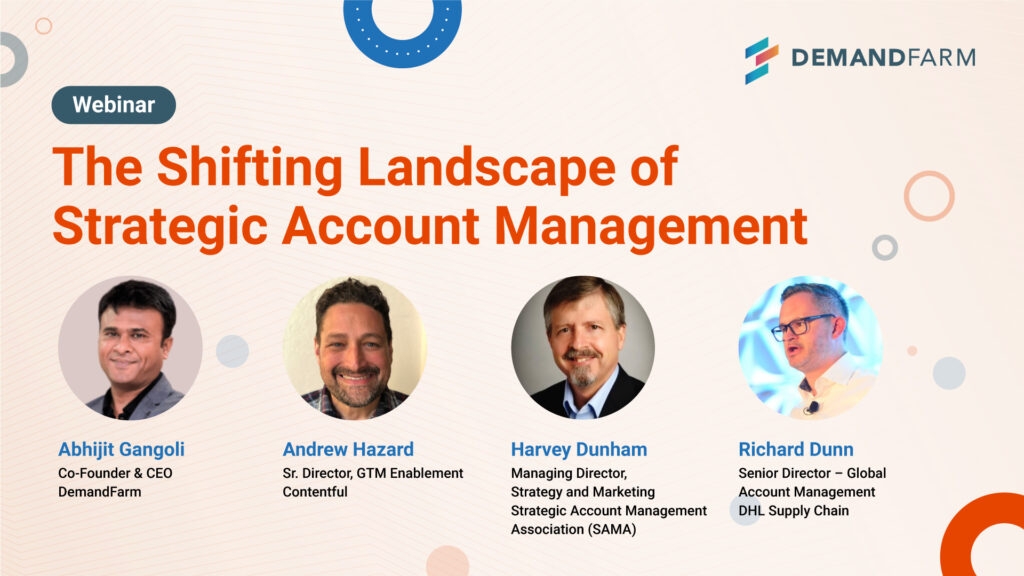
The Shifting Landscape of Strategic Account Management – Webinar by DemandFarm & SAMA As Key Account Management adapts to a fast-paced digital environment, how do you foresee its future? Our panelists discuss shifts in course in the Key Account Management journey including newly emerging tools and technology, growing skill requirements and fresher blueprints for Strategic Account Management to be prepared for the future of the Key Account Management landscape. Agenda: What has changed in Key Account Management (KAM) post-COVID? What are the top contributors to a successful KAM program What are the key skills and tools required for effective KAM in the future? How will digital Key Account Management change the selling experience, going forward? Speakers: Abhijit Gangoli Co-Founder & CEO DemandFarm Andrew Hazard Sr. Director, GTM Enablement Contentful Harvey Dunham Managing Director, Strategy and Marketing Strategic Account Management Association (SAMA) Richard Dunn Senior Director – Global Account Management DHL Supply Chain Watch the webinar on-demand:
What DemandFarm brings to the table! (Milind Katti at the SaasHoles Podcast)
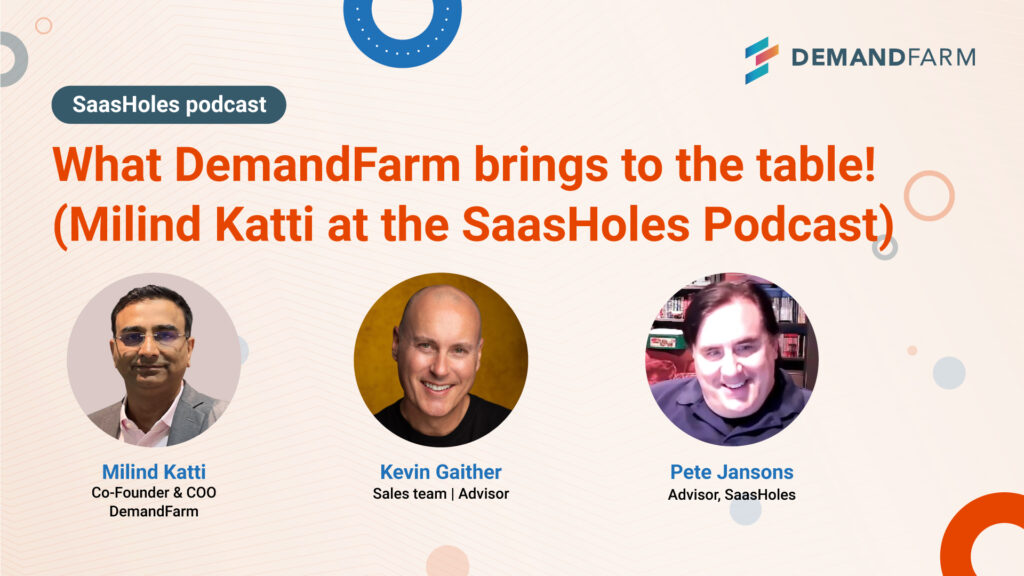
Milind Katti at the SaasHoles Podcast Key Account Management is rapidly changing from traditional methods to becoming digitized. Watch Milind Katti, COO & co-founder at DemandFarm, in conversation with Kevin Gaither and Pete Jansons in the SaasHoles podcast. Find out how DemandFarm came to be pioneers in Digital Account Planning. Track the shift from individual-driven to data-driven account planning. Get to know the benefits of converting tacit knowledge to enterprise memory. Check out the following topics in this podcast: Relationship Mapping & Account Management Building relationships as account managers The role of automation in SaaS Hunters vs Farmers in business
Top 3 Highlights of Dreamforce 2019

Dreamforce 2019 Dreamforce – undoubtedly one of the largest tech events in the world. Salesforce’s massive event gathers more than 170,000 attendees at the Moscone Centre in San Francisco. Dreamforce 2019 was an electrifying week filled with innovation, excitement, and inspiration. 4 Days; 2,700+ sessions; 50+ speakers Did you get a chance to catch up on any of the keynotes or ‘fireside chat’ between Marc Benioff and Apple’s Tim Cook? But other than these wonderful conversations, there are few important highlights of Dreamforce 2019 which you need to know! Welcoming the Newbie – Tableau Since Salesforce’s acquisition of Tableau for a whopping 15.7 billion in an all-stock deal in May, lots of efforts are put in to employ the massive capabilities of the leading analytics platform inside Salesforce. Salesforce has also made huge investments in AI which can boost Tableau’s efforts shortly. In the keynote, Adam Selipsky, President and CEO spoke about the need for building a data culture within every organization. Starting the keynote, Selipskya specified the merger as a “natural combination” to join Salesforce. In terms of fit & overlap, Selipsky and Benioff gave a high-level overview of what to expect. Anyways, users and partners can definitely expect some high-level analytical advancements in the Salesforce platform very sooner. ‘Hey Einstein’ – Voice to Customer experience ‘Hey Einstein’ is similar to Alexa or Google’s assistant but a more focused solution for the workplace. It’s all about bringing Salesforce closer to the community by introducing voice access to Salesforce data which will enable salespeople to quickly access data on the go and to ask the system questions about their data. Salesforce is soon launching a tool that will allow companies to quickly build basic Einstein skills to pull up data from Salesforce. Salesforce Chief Product Officer Bret Taylor gave a small demo and added that “We’re really excited about the idea of voice in businesses — the idea that every business can have an AI guide to their business decisions”. The list of announcements included. 1. Einstein Voice Skills Ready-made dialogue snippets and tools tailored toward specific roles or industries, designed to help “admins and developers to build custom, voice-powered Salesforce apps”, which could be rendered as Alexa Skills, Google Assistant Actions, or other tasks that can be carried out by voice assistants. 2. Service Cloud Voice Resources that closely integrate contact center functions with Service Cloud-based applications and services, enabling agents to avail themselves of Einstein in all its capabilities through a “unified agent console”. 3. Einstein Call Coaching Console for managers that use conversational data to spot trends and provide sales reps with best practices and insights to support designed to improve customer experience (CX). Trailhead GO One of the key announcements at Dreamforce was a deepening of the partnership between Apple and Salesforce. The Giants – Apple and Salesforce have jointly come up with a new companion app Trailhead Go – a sales coach and learning solution which is compatible with iOS and iPad OS. This also implies that no Android for now. Announced in Dreamforce and now integrated with the Salesforce Sales Cloud, Salesforce has entered into the Edutech market providing its users and partners with the best technology resources. Though priced at $25, it’s worth it because of new enhancements of AI and Voice power. Also note that Salesforce has redesigned and launched its Salesforce Mobile app with advanced features like deeper analytics and insights to users, using Siri shortcuts and FaceID with Apple’s design features. It’s completely free and is available in the app store. Conclusion With all these exciting announcements about partnerships and developments, Dreamforce 2019 has ended up leaving us excited for the future of technology. What was your highlight of Dreamforce 2019? Write to us and also stay tuned for our next blog on ‘Account Planning sessions in Dreamforce 19 – Everything you need to know!’
√ New Year √ New Plan ? New Pain
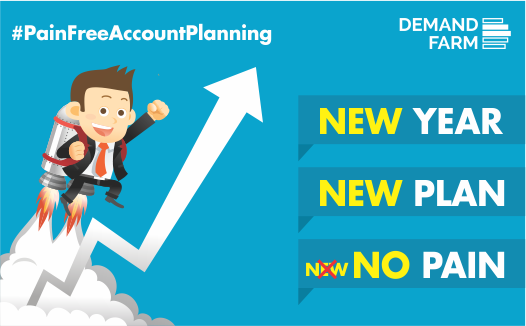
It is the end of the year, and before we can enjoy the Christmas bonus and stuffed turkey, Key Account Management professionals have the unenviable task of reviewing the past year and creating account plans for 2017. You have probably been doing it every year, so you have a basis or a template, and all you need to do is update that, add projections, etc. But is it that simple? It is not just a sales projection; it is an account plan. We can think of dozens of questions you need to answer while planning for a key account and you can probably add on to the list as well. So where and how do you begin? Before you dig out last year’s account plan formats, the old ppts or excel sheets ask yourself these questions; “How are KAM professionals in competitor organizations and other industries preparing their account plans? Is my old method the best, most efficient way? Is there a way to make account planning easier, or to create a more thorough, robust account plan?” If you have paused to think about these questions, your first step has been in the right direction! Our experience providing KAM technology for IT service industry clients has shown us that they face challenges that are often uniquely different from those faced by other B2B industries. As we examine these challenges, we reflect on how they affect account management and how technology can ease the pain and assist with account planning. Service, an Intangible Product Organizations that have a tangible product can easily demonstrate and communicate the uses and benefits of the product. Therefore they depend primarily on the product quality and back that up or accentuate it with a brand. In contrast, the service industry has an intangible product whose benefits are not as easily demonstrable. Therefore trust or a brand name and depending on relationships and people is what attracts and retains customers. One of the benefits of KAM technology is its ability to calculate the relationships mapping strength of key accounts. Another is the convenience of having a unified view of organizational hierarchy, showing all people related to the key account, in the client’s firm and yours. Making an account plan is easy if you use all the relationship related features offered by technology; use CRM as a base, drag and drop to create a key account’s organizational hierarchy, assign a status to people based on their affinity for your company and services, plan periodic interactions between people from different hierarchical levels and more. The result, #painfreeaccountplanning, and the confidence that it provides metrics on relationship strength and throws up warning indicators as well. This year you can use specialized key account management technology to create a well-articulated account plan, one that converts relationships from hurdles into the backbone and strength of marketing. Interaction between the buyer and seller Research by Rawson, Duncan, and Jones found that customers of service industries judged satisfaction based on cumulative experiences across multiple touchpoints. In other words, each time the customer interacts with you, be it the receptionist at your head office, the automated caller menu and every client service assistant and manager, he or she is judging the experience and consciously or unconsciously rating his or her experience. A product has only one or at best a few touchpoints between the seller and the buyer. On the other hand, providing a service has multiple touchpoints throughout the life cycle of the service contract. Therefore more white space opportunities to delight or disgust the customer! Knowing this, who wouldn’t want to track customer interactions in a systematic and objective way? The solution- use KAM technology to collaborate with internal stakeholders, enumerate mutually agreed expectations and targets, and create a unified action plan. This is your chance to plan systematically and make each touchpoint an opportunity to delight your strategic account management. Make or Buy Conundrum In keeping with the holiday season, imagine you are a manufacturer of chocolates who finds he has the insufficient inventory to meet demand. Would you think of buying a cocoa plantation to increase your raw material supply, or of manufacturing a machine to temper chocolate? Probably not. You are most likely to approach sellers and buy them outright, even if you had to increase production at the cost of lower margins. But what if an IT service provider approached you with software that could better estimate cyclic consumption and enable you to plan production and inventories such that you would not face seasonal crunches? Would you consider it right now, put it off till after the holiday season production rush, wonder if the investment would really pay off or think about whether you could do something similar in-house? If you said yes to either of the last two options, you have just highlighted the challenge of selling services. Services, particularly IT services, are rarely perceived as immediate requirements. Their investment-outcome ratio is endlessly debated and often an in-house, home-grown alternative is chosen. Can you overcome the make or buy conundrum? One way to do this is to sell solutions, not services. KAM technology enables you to systematically catalog client requirements, understand the client’s end goal and align your company’s products and services to offer solutions accordingly. While key account planning this year, you can use technology to create a whitespace analysis and depending on the results, design and offer the right solutions to a key account. Creating new avenues of business from an existing client not only adds to your revenue, but it also makes the client feel valued because you are proactive in helping them meet their end goal. Customized versus Standardized Products tend to have standard specifications. Any variations or customizations are generally made at the request of customers. Hence the cost of customization is relatively easy to calculate and is often passed on to the customer. But when you sell a service as a solution, not a product, you have to customize the service
Where’s the HUMOR in Technology?

In Key Account Management , we have all witnessed the evolution of data management from its manual form to the present day digital avatar. The term ‘digital’ itself encompasses the evolution from spreadsheets and basic sales tracking software to the highly specialized Key Account Management software and solutions we see today. While the power of technology to transform the way we manage and interact with our most valuable customers is well accepted across verticals, choosing the right technology and its scope can still be a challenge for many sales professionals. A good place to start may be to think about the areas of transformation and the potential impact in those areas. Over the years, we have recorded a dizzying array of parameters to consider, and that is not including the unique circumstances of specific industries and organizations. We have distilled the former down to what we call ‘HUMOR’, a starting point to approach the overwhelming challenge of choosing technology that works for you. Harnessing the Hidden Value of Key Accounts Most salespeople would agree that in the twentieth century increasing the top line was synonymous with maximizing the number of customers. Over time new statistics such as customer acquisition costs gained focus and in the twenty-first century, retaining and maximizing the potential of existing customers, particularly of Key Accounts, has become critical to increasing the top line. But we have all faced the drawbacks of departmentalization and specialization that make it difficult for individuals in large companies with multiple products and competing divisions to see the company, or the customer, as a single entity. One way in which key account management tools can help address this lacuna is by creating a comprehensive grid, with the company’s offerings on one axis and customer requirements on the other. Each square in the grid can be analyzed to ascertain whether the company has engaged with the customer for a particular product offering and whether it succeeded in exploiting the customer’s buying potential. Technology can be a great enabler to reveal the untapped potential of Key Accounts. DemandFarm’s Whitespace Analysis tool uses a Key Account’s financial and relationship mapping data to calculate and color code squares in a grid. The colors represent the health of engagements or orders and new business in the pipeline. The analysis reveals white spaces in the grid or unexplored white space opportunities for new business from that account. Targeting white spaces unlocks the hidden value of Key Accounts and maximizes the potential of existing customers. A case in point is a multinational pharmaceutical company whose sales force was grouped into divisions based on therapy. Salespeople from multiple divisions were visiting some of the same hospitals and doctors, yet each division had its own list of Key Accounts. The company implemented KAM technology and white space analysis revealed that several specialist doctors were being targeted by only one or two therapy divisions, although in practice these doctors wrote prescriptions covering a wide range of the company’s products. As a result of the analysis, the company re-engineered its sales focus and was able to achieve significant growth by exploiting the potential of Key Accounts. Unified Vision, Unified Action At some point in our careers, most of us have witnessed or been part of a vision, mission or brand identity exercise and the time, effort and cost associated with it. But often we observe that when it comes to sales, companies are reluctant to invest in KAM technology. When we dig deeper, we find that investments or budget are not the hurdles, it’s the worry that a unified action plan won’t have all the details or will be too rigid that is the hurdle. How does KAM technology work? The software includes all the details by pulling in data from CRM (Customer Relationship Management) and ERP (Enterprise Resource Planning) systems. Technology is used to aggregate the data, identify gaps, prompt users to fill in these gaps, analyze the data and calculate and display financial and relationship metrics for each Key Account. The result is a unified platform for Analysis, Planning, Tracking and Presentation of everything related to Key Accounts. It results in a single system with a macro view that can be drilled down to micro details. As a user, you can fill in details, make changes and view plans and performance depending on your requirements and access permissions. The CEO might be interested in the Grandstand™ view, the Sales Head in the Account Review, the Key Account Manager in his achievement to target and salespeople in the customer’s organizational hierarchy and contact information. Making your Data work for you Companies create and maintain some form of sales data, whether by using software like Salesforce or an in-house methodology. The financial data are usually recorded using accounting software and shared through spreadsheets. This is a classic case of fragmented data in silos that do not have a common interface. As an Account Manager, you have probably waded through this minefield of data, collecting information from various sources to try and get a complete picture of the account. You have experienced first-hand the time and worry associated with this process. Fail to collect all the relevant data or make a mistake in transcribing it and all your plans go awry. And no matter how you interpret the data, someone is sure to disagree. In all likelihood this thought has crossed your mind more than once; “Stop wasting your Account Manager’s time collating information, analyzing it, generating reports and creating presentations.” We would like to add “Let these activities be done in the most efficient way- using technology.” KAM software is designed to avoid re-entry of data, seamlessly interfacing with a CRM or ERP system and pulling in data from multiple sources. The time saved and the improved quality of information and analysis enable the Account Manager to focus on growing Key Accounts instead. Ongoing Engagement Is Strategic Account Management all about relationships? About the salesperson who grew the account, risking his time
This Thanksgiving, Join Me in Celebrating You
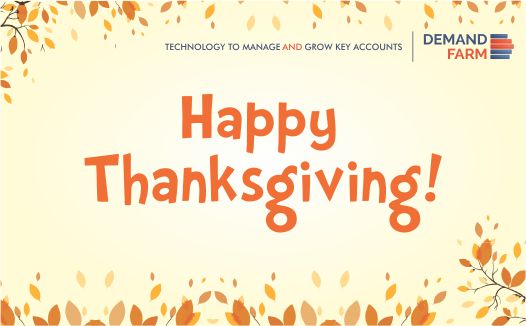
Thanksgiving. The perfect time to take a moment and reflect on the things we are grateful for and celebrate them. This year, we are celebrating the fact that we have so much to be grateful for and so much to celebrate! To all the Sales Visionaries who took the idea of selling to Key Accounts – and turned it into the art and the science that Key Account Management is today. We hope you keep setting the bar higher for us. Thank You. To all the technocrats who kept seeking – and finding- better ways to do things…from sales automation to sales enablement, automation, and now, KAM Tech. We look forward to building the future with you. Thank You. To all our supporters – the team at DemandFarm, Our Partners, Our Vendors – we wouldn’t be here without you. There is no greater joy than to grow with you. Thank You. To all the believers – the early adopters – the Sales Leaders, Key Account Managers, Sales Ops teams – who led the change by asking, ‘can technology transform the way we manage and grow our Key Accounts’? We value the opportunity to serve you. For, to serve you is to celebrate you. Thank you. I hope you have a magical Thanksgiving with the ones you love and cherish.
Interview with Olivier Riviere – Consultant & Head of the KAM Practice at Invalio

Olivier tell us about your journey as a Key Account Management Professional and how do you help companies achieve growth through focusing on their strategic partnership with the key account? In the course of my career, from junior team member to Executive in charge of Key Clients, I have always been involved in the relationship with truly strategic customers across various industries: design and manufacturing, semiconductors, Entreprise Software and B2B Marketing & Communication Services. In addition, and I am grateful for this, my job also always included driving a true co-creation process with strategic customers and initiatives aiming at influencing the whole business ecosystem. When I became a consultant, I have quite naturally put these topics at the core of my activities. With my partners, we help companies of all size, analyze their strategic context, customer portfolio, and organizational dynamic in order to design and implement a KAM/GAM approach in line with their strategy, resources, and culture. I insist on working simultaneously on the KAM system AND the people involved in KAM; their skills, their motivation and how they collaborate and with their Customers. When is the right time for businesses to start looking at their client relationships in the more strategic manner? There are many reasons why companies should run a sharp analysis of the true value of each Customer and drive the engagement with selected Accounts more strategically. In theory, you can start at any time and the sooner, the better. As an example, start-ups operating in a B2B environment could take advantage of using KAM techniques upfront, although very few do it. In reality, for medium-size and large companies, the trigger situation for KAM comes from a combination of internal and external factors. The major internal factor is when the Executive Team realizes that KAM is a powerful instrument to accelerate the execution of the company’s strategy, whatever its specifics. The external factors are related to an evolution of the environment: market concentration, competitive threat, new regulation, or the need for more innovation. The trigger situation can also simply be the request of a few Customers to receive special treatment. All in all, it is the job of the Executive Team to assess when to start KAM, and it is an area where some external help can bring very high value. What are the biggest obstacles you see businesses face toward becoming more oriented toward servicing & acquiring a deeper understanding of their strategic accounts? The biggest obstacle is definitely the culture. Exploring the true value of each customer and categorising them accordingly, developing a deep sense of the real Customer Experience and where it matters to improve it, further developing the network of personal relationships with Key customers, all of this requires teamwork, collaboration, and the capacity to drive a sustained collective effort that cuts across disciplines and organisational boundaries. Most companies and not only large ones have difficulties to do this. When you look at why KAM initiatives fail to deliver on their promise, the lack of attention paid to cultural change is always part of the picture. Another frequent challenge is the lack of depth of the analysis of the Key Account organization and the network of relationship. The superficiality of the analysis prevents the vendor’s team from finding new angles to strengthen the ties with strategic customers. Software is eating the world & account management could not escape! Do you feel there is a need of having specialized platforms or software for strategic account management? The answer is definitely yes. CRM systems are currently not adapted for true KAM.and other tools are required. This being said there are different sort of needs that can be covered with an adequate software application. Account Planning and monitoring of execution Definition and management of the Value Proposition Opportunities & Share of Business Management Relationship & Influence Management Communication and Operations (team portal and customer portal) These 5 themes are quite differentiated although they do overlap. I am not sure that a single platform will be able to cover all these needs at the same level of depth and for all type of companies in the near future, but I do not see this as a big problem. Companies need to assess their needs and explore where they should consider adding one or several KAM specific tools to their existing software stack (or replacing old applications by new ones). Will such tech platforms become ‘a must have’ for account managers and their leadership or do you feel it constitutes ‘a nice to have’ capability? We are in a transition era. Commercially available Software tools for KAM are just emerging. I strongly believe that the trend will accelerate rapidly and that the benefits of such platforms will be increasingly recognized by more and more KAM and IT professionals. As the awareness of such tools, and probably the breadth of the offering, improve, KAM practitioners will have to avoid to reproduce the same deadly mistake as in CRM: namely putting the tool before the people. KAM software tools will bring value only if the KAM methodology and toolset used by a company are adequate and if the KAM teams – all people involved in KAM – are sufficiently skilled. Such needs are not covered by any piece of software but by Skills development through training, on-the-job coaching, and experience sharing and by a true focus on teamwork. What is your one mantra for growing strategic client relationships? Act like an entrepreneur. Be able to think and help others think out of the box and secure support for these new ideas. In addition, don’t be rebuffed by resistance and demonstrate patience. Would you like to share an interesting business book you have recently read and what was the key takeaway for you? I recommend “Give and Take, Why Helping Others drives our Success by Adam Grant”. One of my customer, Head of KAM in a German industrial company, has used this book to open the eyes of his colleagues
Its Q, not James Bond

“I’ll hazard I can do more damage on my laptop sitting in my pajamas before my first cup of earl grey than you can do in a year in the field.”– Q The Role of technology in marketing has been growing exponentially in the last few years. It started evolving with functions like accounting, inventory management, project management. Then came technologies to automate sales, service and most recently, marketing. There are a lot of great technologies available now, and like you, I have tried some of them in my own marketing strategies. Needless to say, technology, tools, gadgets- all of them exist to improve efficiencies of the user, save time, money.. whatever. But when it comes to using technology for marketing particularly, we have a unique phenomenon. Marketing is an art as much as a science – it’s not like a production line or logistics management. And you can never fully automate the ‘art’ aspect of marketing- that still needs a really competent human- i.e. Marketing or Account Manager to lead the effort intelligently. The Key account management tool exists to enhance all of the inherent skills of the Marketer and enable victory. Let’s illustrate this with a really simple example. I bought a fantastic e-mail marketing tool once and thought it would do wonders. But, without a great subject line (headline) that makes sense to the recipient and without really great, relevant content, the email tool is useless. In fact, it could be detrimental and annoy my prospects. In developing DemandFarm over the last 3 years, I set out to make a James Bond-like the tool that solves everything effortlessly and wins the confidence of the most difficult customers. But recently while watching a James Bond film, it dawned upon me that DemandFarm is ‘Q’, not James Bond. For the uninitiated, Q is the nerdy genius providing Bond with all his gadgets. In reality, the user of my product (Key Account Manager) is James Bond. I was trying to make DemandFarm a James Bond. It is imperative for Bond to have a Q at his side. Think for a second, what makes James Bond exceptional?The swag, the license to kill or the awesome gadgets that get him out of every near-death situation he gets himself into? All the tools Bond owns come from Q – the Jetpack, laser shooting Omega Seamaster Professional watch, every gun, every bullet in that gun and the Aston Martin. Bond is incomplete without the modified Aston Martin built by Q. The car is a veritable tank, providing the bond with a companion he can count upon every time. It’s Q’s gadgets that make the man on her majesty’s secret service a living weapon. So for every James Bond of a Key Account Manager out there, dial ‘demandfarm.com’ for your very own Q.